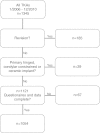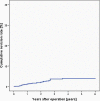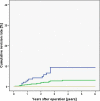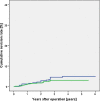Influence of computer navigation on TKA revision rates
- PMID: 22949123
- PMCID: PMC3479285
- DOI: 10.1007/s00264-012-1606-6
Influence of computer navigation on TKA revision rates
Abstract
Purpose: We performed this study to determine whether the use of imageless navigation reduces revision rates after total knee arthroplasty (TKA).
Methods: Data of 1,121 consecutive primary TKA with a follow-up of one to six years were retrospectively analysed. Following the conversion of the standard technique from conventional to navigated procedures, these data included the last 342 conventional and first 779 navigated procedures performed in our clinic. Demographic and perioperative covariates were recorded. All patients were asked by post to report instances of revisions.
Results: Data of 1,054 patients (94 %) were complete. Mean follow-up was 3.9 years for conventional and 2.4 years for navigated operations. Cumulative revision rate averaged 4.7 % for conventional and 2.3 % for navigated procedures. Cox's proportional hazard model was used to assess the effect of covariates on survival, resulting in significantly lower revision rates for older patients (p < 0.001) and for the navigated technique (p = 0.012). The reduced revision rate for navigated operations was mainly caused by a significantly reduced rate of aseptic implant loosening (1.9 % vs. 0.1 %, p = 0.024).
Conclusions: Our study showed lower revision rates when computer navigation was used. However, due to the retrospective uncontrolled design, further prospective trials will be necessary to further evaluate this effect.
Figures




Similar articles
-
Population-based Survivorship of Computer-navigated Versus Conventional Total Knee Arthroplasty.J Am Acad Orthop Surg. 2020 Oct 15;28(20):857-864. doi: 10.5435/JAAOS-D-19-00548. J Am Acad Orthop Surg. 2020. PMID: 31934926
-
Reduced postoperative morbidity in computer-navigated total knee arthroplasty: A retrospective comparison of 225,123 cases.Knee. 2021 Jun;30:148-156. doi: 10.1016/j.knee.2020.12.015. Epub 2021 Apr 27. Knee. 2021. PMID: 33930702
-
Computer navigation for total knee arthroplasty reduces revision rate for patients less than sixty-five years of age.J Bone Joint Surg Am. 2015 Apr 15;97(8):635-42. doi: 10.2106/JBJS.M.01496. J Bone Joint Surg Am. 2015. PMID: 25878307
-
A Comparison of Long-Term Outcomes of Computer-Navigated and Conventional Total Knee Arthroplasty: A Meta-Analysis of Randomized Controlled Trials.J Bone Joint Surg Am. 2019 Oct 16;101(20):1875-1885. doi: 10.2106/JBJS.19.00257. J Bone Joint Surg Am. 2019. PMID: 31626013
-
Complications and failures of non-tumoral hinged total knee arthroplasty in primary and aseptic revision surgery: A review of 290 cases.Orthop Traumatol Surg Res. 2021 May;107(3):102875. doi: 10.1016/j.otsr.2021.102875. Epub 2021 Feb 27. Orthop Traumatol Surg Res. 2021. PMID: 33652151 Review.
Cited by
-
Clinical, radiological and survivorship results after ten years comparing navigated and conventional total knee arthroplasty: a matched-pair analysis.Int Orthop. 2017 Oct;41(10):2037-2044. doi: 10.1007/s00264-017-3509-z. Epub 2017 May 26. Int Orthop. 2017. PMID: 28550426
-
Inconsistencies between navigation data and radiographs in total knee arthroplasty are system-dependent and affect coronal alignment.Can J Surg. 2014 Oct;57(5):305-13. doi: 10.1503/cjs.031313. Can J Surg. 2014. PMID: 25265103 Free PMC article.
-
Computed Tomography Analysis of Postsurgery Femoral Component Rotation Based on a Force Sensing Device Method versus Hypothetical Rotational Alignment Based on Anatomical Landmark Methods: A Pilot Study.Adv Orthop. 2016;2016:4961846. doi: 10.1155/2016/4961846. Epub 2016 Jan 4. Adv Orthop. 2016. PMID: 26881086 Free PMC article.
-
No difference between computer-assisted and conventional total knee arthroplasty: five-year results of a prospective randomised study.Knee Surg Sports Traumatol Arthrosc. 2013 Oct;21(10):2241-7. doi: 10.1007/s00167-013-2608-7. Epub 2013 Jul 14. Knee Surg Sports Traumatol Arthrosc. 2013. PMID: 23851969 Clinical Trial.
-
How are we addressing ligament balance in TKA? A literature review of revision etiology and technological advancement.J Clin Orthop Trauma. 2016 Oct-Dec;7(4):248-255. doi: 10.1016/j.jcot.2016.04.001. Epub 2016 Aug 3. J Clin Orthop Trauma. 2016. PMID: 27857498 Free PMC article.
References
-
- Berend ME (2009) Computer-assisted TKA: greater precision, doubtful clinical efficacy: affirms. Orthopedics 32 (9):orthosupersite-24 - PubMed
Publication types
MeSH terms
LinkOut - more resources
Full Text Sources
Medical

